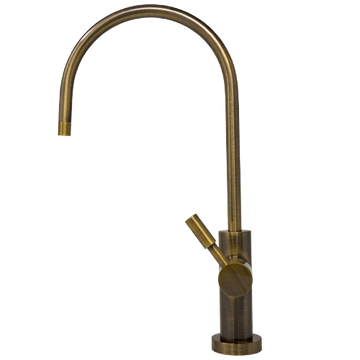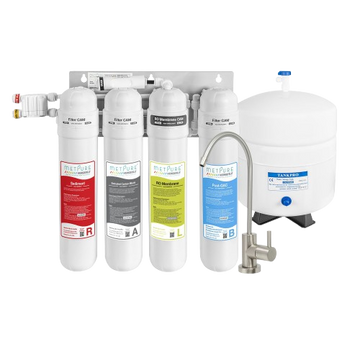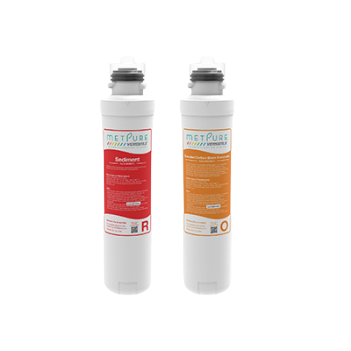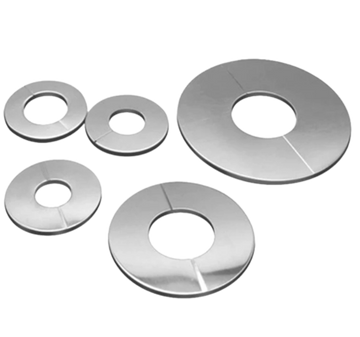Every homeowner experiences faucet leaks and drips in the kitchen and bathroom. Whether it's pooling of water or a slow stream, leaky faucets need prompt attention. Not only is it wasteful for the water, but leaks only ever get worse, becoming a headache you can't ignore soon.
Luckily, the repairs are easy to make, and we'll walk you through it in this blog
Common Causes of Faucet Leaks

Wear and tear is the most common cause of a faucet leak. If your faucet has overstayed its warranty by a couple of years, wear and tear of some parts is normal.
Most of the time, you just need to repair faucet leaks. But if your faucet has multiple broken parts, a whole change might be smarter.
Other common reasons can include;
-
Improper Installation
Issues like loose handles, faulty cartridges, and bad fitting can let water waste and rack up your bills.
These are more prevalent in washerless faucets, plus when inexperienced homeowners try to DIY. A simple sign of wrong installation is pooling of water at the base of the tap. How to do proper faucet installation under the sink? Guide!
-
Uneven Water Pressure
Uneven water pressure is another culprit when it comes to pesky dripping bathroom faucets. When the water pressure is too high, it backs up in pipes, and eventually starts leaking by breaking through packing and valves.
At the same time, if water pressure is low, it won't travel through pipes correctly, and drip through nearest faucets.
-
Heat Exposure
Heat exposure puts great stress on your plumbing- faucets included. Sustained heat can damage rubber seals and reduce their functionality, causing leaks.
If your faucet has direct sun exposure, the metal can expand and contract, making the fittings loose. Heat exposure includes both the atmospheric heat and super hot water.
The material of your faucet also plays a part. Cheap plastic faucets are often bad with hot water and break down quicker. Brass and nickel faucets have a longer, more fireproof lifespan.
-
Sediment Build-Up
If you live in an area with hard water supply or use well-water, you may find crusty white deposits or rusting on the metal parts of your faucets. These are corrosive chemicals that wear your faucet out. Regular maintenance can slow this down.
Additionally, if you don't use a particular faucet often or have moved into an old house, it's possible there's mold causing damage to the faucet.
Note: These can damage specific parts of the faucet, leading to either leak from the base or handle, or constant dripping.
Why Do Faucets Leak at the Handle?

A leaky faucet handle can stem from two main reasons- a damaged O-ring or a packing nut coming loose.
Damaged O-Ring
An O-ring is a part of cartridge faucets for the kitchen. It holds the valve in place, bridging the gap between the handle and screw. It's a small ring made of rubber and can become loose or tear off, especially if you move the faucet head too much.
When this happens, water starts leaking from under the faucet handle, forming a pool.
To examine the O-ring, you first need to remove the cartridge and look for a black rubber ring at the base of the faucet. If this appears loose, tighten it with a wrench. If it appears degraded, order a replacement.
Loose Packing Nut
Packing nuts or adjusting rings are found near the base of both kitchen and bathroom faucets. They can be damaged because of your basic wear and tear, plus bad installation and vibration damage- which lands from rough use or high pressure conditions.
Most of the time you just need to tighten the adjusting ring with a wrench and that's it. However if the leaks continue, you need to inspect the whole faucet, as some spring or shutoff valve may be the culprit.
Faucet Dripping After Being Turned Off? Here's The Reason.
Did you turn off the handle as hard as you physically could yet the dripping bathroom faucet keeps annoying you? It's likely due to a corroded valve seat or broken washer.
Both are sealing components that normally block leaks, but sediment and pressure damage can hinder their function.
Corroded Valve Seat
Valve seat is located at the base of your faucet handle, and it has a small hole that lets water through. Corrosion damages the sealing properties of this, creating gaps between the seat and faucet stem. Naturally, water and gas escape. Severe cases may have cracking too.
If it's a brass seat, you can resurface it. However, there's no saving plastic, and you'll need replacement.
Broken Washer
The washer is a small, often beveled rubber or plastic disc held at the faucet stem, where water enters the sink. It's usually held in place with a brass screw, which being metal can corrode, causing leaks.
If you notice a consistent slow drip, then a faulty washer could be the diagnosis. A simple replacement can be DIY-ed.
Step-by-Step Guide to Fixing Faucet Leaks

Before we get into the specifics of how to fix kitchen and bathtoom faucet drips, you need to figure out what kind of faucet you have, learn about types of faucets
- Compression Faucets have two handles for hot and cold water. They usually drip from old washers and worn-out valve seats in the stem.
- Cartridge Faucets can have one or two handles and run on a plastic cartridge that controls water flow. Improper installation and cartridge damage plagues this type.
- Ball Faucets have a single handle mechanism moving over a ball inside. They're more common in bathrooms and can have multiple small parts damaged.
- Ceramic Disc Faucets are a newer design and have a single, durable handle with two discs inside. If water seeps here, suspect disc damage.
Once you've identified the right faucet type, you can start the fixing process.
Regardless of whether you have a leaky handle or dripping water, the first two steps remain the same.
Step 1: Turn The Water Supply Off
Before starting repairs and spraying yourself with a fountain of water, turn your local (or entire home) supply valve off.
Step 2: Disassembly
- For compression faucets, remove the decorative cap then unfasten the packing nut with a wrench.
- For cartridge faucets, screw off the decorative cap and handle with a screwdriver, then remove the retaining clip and lift the handle out.
- For ball faucets, you need a ball faucet repair kit, which has a tool that removes the retaining clip.
- For disc faucets, take the escutcheon cap out, then use needle nose pliers to loosen the nuts.
How to Fix a Kitchen Faucet Leaking at the Handle
For a kitchen faucet leaking at the handle, the cause is normally a damaged O-ring or packing nut.
Step 3: Inspection of Worn-Out Parts
After disassembly, you can access the stem. Locate the ceramic disc, cartilage, and o-ring. Look for visible signs of cracking and corrosion. In case of leaking handles, check the nuts and screws too.
Step 4: Replace and Reassemble
If there's damage to the cartilage disc or o-ring, then you need to get a replacement from a nearby hardware store or your faucet brand.
O-rings are small rubber rings that form the seal. These need replacement only. Coat these with plumber’s grease after applying.
Ball faucet stem is a special case and needs its own repair kit that inspects multiple components.
Afterwards, just simply reassemble in the reverse of initial disassembly. Start with the valve stem & cartridge, moving to the handle. Secure everything tightly with a retaining clip/packing nut and seal with plumber's tape.
Step 5: Leak Test
Finally, turn the water back on slowly for pressure adjustment and check for any leaks.
How to Stop a Bathroom Faucet Dripping After Turned Off
Step 1: Assess The Faucet Stem
For dripping bathroom faucets (or kitchen ones), look for damage to the washer and valve seat.
Step 2: Make Repairs/Replacements
Washers in compression faucets are inside the stem, below the O-ring. These rubber parts also need exact replacement.
Valve seats are at the base of the stem, below the washer. These are normally metallic and need cleaning. Broken ones need replacement.
Step 3: Reassemble and Test
Once done, reassemble according to your faucet style, making sure the valve seat and washer sit tightly in the stem. Use a plumber's tape as an added layer of protection.
Finally, slowly release the water pressure valve and close the tap. Check if any dripping still continues.
Preventing Future Faucet Leaks
Bought a premium quality faucet that matches your kitchen or bathroom vibes? You can hold onto it for longer with small habits that prevent major leaks.
Leak Inspection
Before an evident faucet leak, you can regularly inspect small dripping and puddles. At this stage, leaks are often from one worn out component and can be easily addressed.
Maintaining Water Pressure
If you want your faucets to perform optimally, make sure you're sending the right water pressure their way. Uneven water pressure causes pooling around other pipes too, so it's easy to spot.
Warranty Check
Because fixtures are easily forgotten about until a faucet leak shows up, homeowners often don't remember about warranties. Truth is, many faucets come with years, even lifetime of warranty for replacement parts. It's always good to check your manufacturer warranty so you don't buy parts already covered.
Proper Installation to Avoid Leaks
Proper installation of each faucet is key to having well-functioning fixtures. If you're doing DIY projects choosing right faucet is must, make sure you tighten every screw and close every seal. Use plumber's grease and plumber's tape to make the system intact. If you're uncertain, calling a professional should always be an option.
Maintenance Tips for Long-Lasting Faucets

Use these basic maintenance tips to extend your fixture's life.
Regular Cleaning
Yes, regular cleaning keeps your faucets shiny and pristine, but it's also good to stop any sediment from building up.
To clean the faucet well, we suggest using a mixture of mild detergent and warm water, and wiping the faucet down with a washcloth. If there's some stubborn build-up already, you can use diluted vinegar as a cleaner. Afterwards, just dry with a soft cloth.
If you want to keep the showroom look going, we also recommend trying furniture polish. But remember, avoid using harsh corrosive chemicals, as they wear down on both the polish and faucet metal.
Preventing Mineral Buildup
Damage from mineral buildup is a regular issue if you have hard water supply. These deposits clog up the faucet, building backflow pressure and leaking.
One way to rid the lime build-up is using a mild scrubbing solution (though sparsely) or a window cleaner. Vinegar can also work. But keep in mind the finish of your tap- matte ones need special cleaners or lime dissolvers.
Mineral deposit is common around the aerator, so clean it regularly. If the issue reoccurs a lot, consider a water softener system for the house.
Clean the Aerator
Aerators are an essential component that keeps your water flow smooth. They're prone to the same damage as faucet washer or exterior, so cleaning them occasionally is always wise.
To clean the aerator, simply remove it from the faucet, keep the parts in order, and run them under warm water. Use a plain toothbrush for the aerator screen. If there's any hard deposits, vinegar is your best friend.
And if that's all too much, you can get an aerator replacement from a nearby hardware store and swap it out.
Replacing Washers & Seals
As we've learnt earlier, washers and seals are pivotal to a functioning tap- one small break and there's a faucet leak. However, the damage is inevitable with regular use.
Luckily, if you're on top of any damage before it grows big, you will only need to DIY replace a small part. Keep a regular check on your faucet's washer and seals. If you notice any breakage or dripping of water, order a replacement immediately.













